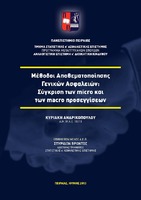Μέθοδοι αποθεματοποίησης γενικών ασφαλειών : σύγκριση των micro και των macro προσεγγίσεων

Προβολή/
Θεματική επικεφαλίδα
ΑσφάλισηΠερίληψη
Για την κάλυψη πιθανών μελλοντικών απαιτήσεων, οι εταιρείες γενικών ασφαλίσεων πρέπει
να διαθέτουν το απαραίτητο αποθεματικό κεφάλαιο, σύμφωνα με τις απαιτήσεις της
ευρωπαϊκής οδηγίας Solvency II. Για το λόγο αυτό, είναι εξαιρετικά σημαντική η αξιόπιστη
πρόβλεψη των μελλοντικών χρηματικών ροών με τη βοήθεια των αναλογιστικών μεθόδων
αποθεματοποίησης. Γενικά, οι περισσότερες μέθοδοι βασίζονται σε συγκεντρωτικά τρίγωνα
run-off και παρουσιάζουν σημαντικά μειονεκτήματα. Πρόσφατα ωστόσο έχουν προταθεί η
λεγόμενη μέθοδος "μικρο" (micro), οι οποίες, αντί να βασίζονται σε συγκεντρωτικά
δεδομένα, εκμεταλλεύονται τα αναλυτικά δεδομένα που τηρούν οι ασφαλιστικές εταιρείες
στα αρχεία τους σχετικά με τις απαιτήσεις που καλύφθηκαν στο παρελθόν. Επιλέγοντας
κατάλληλα στατιστικά μοντέλα με βάση το ιστορικό της ασφαλιστικής εταιρείας, η μέθοδος
"μίκρο" υπόσχεται πιο αξιόπιστη πρόβλεψη των μελλοντικών απαιτήσεων.
Στόχος της παρούσας διπλωματικής εργασίας είναι η μελέτη του μεθόδου "μίκρο" και η
σύγκρισή της με τις κλασικές μεθόδους συγκεντρωτικών τριγώνων run-off. Αφού
δικαιολογηθεί η αναγκαιότητα ασφαλούς πρόβλεψης του αποθεματικού, αρχικά
παρουσιάζονται οι κλασικές μέθοδοι Chain Ladder και οι επεκτάσεις αυτής, η μέθοδος
Bornhuetter-Ferguson και οι μέθοδοι αποθεματοποίησης που κάνουν χρήση γενικευμένων
γραμμικών μοντέλων. Στη συνέχεια, παρουσιάζονται η νέα μέθοδος "μίκρο" που έχει
προταθεί πρόσφατα στη βιβλιογραφία. Τέλος, τα πλεονεκτήματα της νέας μεθόδου
παρουσιάζεται μέσα από μια εφαρμογή στο στατιστικό πακέτο R, χρησιμοποιώντας δεδομένα
που προέκυψαν μέσω προσομοίωσης.


